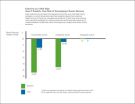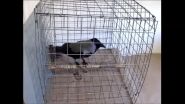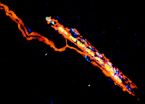INFORMATION:
Reference
Leclere D, Havlik P, Fuss S, Schmid E, Mosnier A, Walsh B, Valin H, Herrero M, Khabarov N, and Obersteiner M. 2014. Climate change induced transformations of agricultural systems: insights from a global model. Environmental Research Letters. http://dx.doi.org/10.1088/1748-9326/9/12/124017
About IIASA:
IIASA is an international scientific institute that conducts research into the critical issues of global environmental, economic, technological, and social change that we face in the twenty-first century. Our findings provide valuable options to policy makers to shape the future of our changing world. IIASA is independent and funded by scientific institutions in Africa, the Americas, Asia, Oceania, and Europe. http://www.iiasa.ac.at
How will climate change transform agriculture?
2014-12-18
(Press-News.org) Climate change impacts will require major but very uncertain transformations of global agriculture systems by mid-century, according to new research from the International Institute for Applied Systems Analysis.
Climate change will require major transformations in agricultural systems, including increased irrigation and moving production from one region to another, according to the new study, published in the journal Environmental Research Letters. However without careful planning for uncertain climate impacts, the chances of getting adaptation wrong are high, the study shows.
The new study by IIASA researchers provides a global scenario analysis that covers nine different climate scenarios, 18 crops and 4 crop management systems, as well as the interactions between crop production, consumption, prices, and trade. It specifically examines adaptations that are investment-intensive and not easily reversible, such as building new water management infrastructure for irrigation, or increases and decreases to the production capacity of a region. Such "transformations" the researchers say, need to be anticipated, but their implementation is particularly plagued by uncertainty.
"There is a lot of uncertainty in how climate change will impact agriculture, and what adaptations will be needed," says IIASA Ecosystems Services and Management researcher David Leclère, who led the study. "Our new study is the first to examine at a global scale whether the adaptations required from agricultural systems are in the transformational range, and whether these transformations are robust across plausible scenarios. By looking at where, when, why, and which transformations are required, but also in how many scenarios, it lays the groundwork for countries to better plan for the impacts of climate change."
In line with earlier results, the study finds that the impacts on crop yields of changes in climate, such as increased temperature, changing precipitation levels, along with the increased CO2 atmospheric concentration (which has a fertilizing effect on plants), could lead to anywhere between an 18% decline in global caloric production from cropland, to as much as a 3% increase by 2050. This biophysical impact varies widely across regions, crops, and management systems, thereby creating opportunities for adaptation at the same time.
By combining these climate and yield projections with the IIASA Global Biosphere Management Model (GLOBIOM)--a global model that includes land use, trade, consumption, water resources, and other factors, the researchers identified the likely needed adaptations and transformations for global agricultural systems.
"Our results confirm that the choice of the climate model used for estimating changes in climate largely shapes adaptations such as moving production from one region to another. But it also shows the importance of how regions are interconnected through trade: for example, in Latin America, where yields are projected to decrease in all scenarios, cropland could increase in some scenarios due to increased net exports to North America. In Europe, where yields are expected to increase due to climate change, cultivated land could decrease depending on the scenario, due to limited export opportunities," says Leclère. Since such major transformations are difficult and expensive to reverse, the researchers say, a comprehensive analysis of interactions between the direct biophysical impacts of climate and market-driven interconnections between regions is vital.
The study also reiterates the importance of limited water resources for future food security in a changing climate, showing that in a large part of the world, increases in irrigation larger than 25% may be required. However, the study found, where this would take place is extremely sensitive to the choice of the climate model as early as in 2030s. Leclère says, "We have known for a long time that changes to rainfall are a major uncertainty. This study shows how important irrigation will be as an adaptive measure, but also how sensitive it is to different climate scenarios."
Overall, the study finds, while adaptations are largely entering the transformational range by mid-21st century, almost none can be found to be robust across all scenarios. "People often say that agriculture is adaptable--that throughout history, agricultural systems have shown a large capacity to evolve," says Leclère, "It's important to examine this assertion further, as achieving a climate-ready global food system will definitely be challenged by the uncertainties at stake."
"After decades of global research efforts, scientists are only starting to understand the implications of climate change for the future global food system" says Michael Obersteiner, IIASA Ecosystems Services and Management Program Director and a study co-author. "We need to explore new and uncertainty-proof paradigms for long-term decision-making, and we also need a much better understanding of how to manage crucial resources such as water, which may become dramatically scarcer much earlier than previously thought."
"Modelling tools are key to generate the knowledge for restraining climate change impacts on food security within acceptable boundaries without increasing the pressure on our resources," says Petr Havlík, IIASA Ecosystems Services and Management researcher and leader of the GLOBIOM modeling team. "Our models show that there is an effective global adaptation strategy to any single climate change scenario. The challenge we face is to find the strategy which fits a hundred scenarios at the same time."
ELSE PRESS RELEASES FROM THIS DATE:
Self-reported daily exercise associated with lower blood pressure, glucose readings
2014-12-18
PASADENA, Calif., December 18, 2014 -- Self-reported moderate to vigorous exercise was associated with lower blood pressure and blood glucose levels in a Kaiser Permanente study published in the journal Preventing Chronic Disease. Data collected from Kaiser Permanente's Exercise as a Vital Sign (EVS) program, in which medical office staff asks patients about their exercise habits at every health care visit, revealed associations between moderate to vigorous exercise and improved measures of cardiometabolic health for both men and women. Few previous studies have examined ...
Scientists locate homing signal in brain, explaining why some people are better navigators
2014-12-18
The part of the brain that tells us the direction to travel when we navigate has been identified by UCL scientists, and the strength of its signal predicts how well people can navigate.
It has long been known that some people are better at navigating than others, but until now it has been unclear why. The latest study, funded by the Wellcome Trust and published in Current Biology, shows that the strength and reliability of 'homing signals' in the human brain vary among people and can predict navigational ability.
In order to successfully navigate to a destination, you ...
Crows are smarter than you think
2014-12-18
VIDEO:
Research from Univ. of Iowa and Russian scientists show crows are capable of executive-level thinking.
Click here for more information.
Crows have long been heralded for their high intelligence - they can remember faces, use tools and communicate in sophisticated ways.
But a newly published study finds crows also have the brain power to solve higher-order, relational-matching tasks, and they can do so spontaneously. That means crows join humans, apes and monkeys in exhibiting ...
Scientists discover tiny gene fragments linked to brain development and autism
2014-12-18
TORONTO -- Very small segments of genes called "microexons" influence how proteins interact with each other in the nervous system, scientists at the University of Toronto have found, opening up a new line of research into the cause of autism.
The researchers found that microexons are used in neurons by alternative splicing, a process in which a single gene can produce many different proteins. Microexons are pasted -- or spliced -- into gene messengers (mRNAs) to generate forms of proteins that the nervous system needs to function properly. Misregulation of this process, ...
Scientists map out how childhood brain tumors relapse
2014-12-18
RESEARCHERS have discovered the unique genetic paths that the childhood brain tumour medulloblastoma follows when the disease comes back, according to research* published in Cancer Cell today (Thursday).
The study - funded by Cancer Research UK, Action Medical Research and others** - shows that taking an extra tumour sample at recurrence, when there are no effective therapies, could identify subsets of patients that might be treatable with existing drugs that target the genetic faults.
The scientists, based at Newcastle University and The Institute of Cancer Research ...
UCL discovery in the fight against antibiotic-resistant bacteria
2014-12-18
There are two main families of bacteria : those that are surrounded by a single membrane (or one outer wall) and those that are surrounded by two membranes (or two outer walls). The team of Jean-François Collet, professor at the de Duve Institute at UCL, looked at this second type of bacteria.
For a bacterium to survive, it has to keep its two outer walls intact. If one of these walls is damaged, the bacterium dies. So it was vital for the UCL researchers to analyse the protection mechanisms of these bacterial "walls' (to find their weak spot), so as to be able to ...
Stem cells born out of indecision
2014-12-18
This latest research by Joshua Brickman and his research team from Danish Stem Cell Center (Danstem) at the University of Copenhagen specifically found that inhibiting or blocking stem cells ability to make a specific decision, leads to better cell growth and could lead to defined ways to differentiate stem cells.
This research is the first comprehensive analysis of a pathway important for stem and cancer cell decisions known as Erk. As a result this work could contain clues to cancer treatment as well as helping to establish a platform to make stem cell treatments for ...
Trigger mechanism for recovery after spinal cord injury revealed
2014-12-18
After an incomplete spinal cord injury, the body can partially recover basic motor function. So-called muscle spindles and associated sensory circuits back to the spinal cord promote the establishment of novel neuronal connections after injury. This circuit-level mechanism behind the process of motor recovery was elucidated by Prof. Silvia Arber's research group at the Biozentrum, University of Basel and the Friedrich Miescher Institute for Biomedical Research. Their findings may contribute to designing novel strategies for treatment after spinal cord injuries and have ...
New research solves old mystery of silent cell death
2014-12-18
Walter and Eliza Hall Institute researchers have for the first time revealed how dying cells are hidden from the immune 'police' that patrol the body.
The research answers a decades-old mystery about the death of cells, which in some situations can alert the immune system to potential danger, but in other circumstances occurs 'silently', unnoticed by immune cells.
Silent cell death, or apoptosis, is a controlled way for the body to eliminate cells that may be damaged, old, or surplus to the body's requirements, without causing collateral damage. This 'normal' cell death ...
Microexons: Small fragments of genes, essential for neurone maturation
2014-12-18
This news release is available in Spanish. The genome is the cell's book of instructions. All the cells in our body contain the same genomic information but each of them "reads" the gene fragments that interest them in order to carry out their function. So, neurones, hepatocytes and cardiac cells are different although their genome is the same. In order to achieve this huge variety of functions from the same genome, the cells employ a mechanism known as alternative splicing. This enables them to combine several fragments - known as exons - from the same genes in order ...



